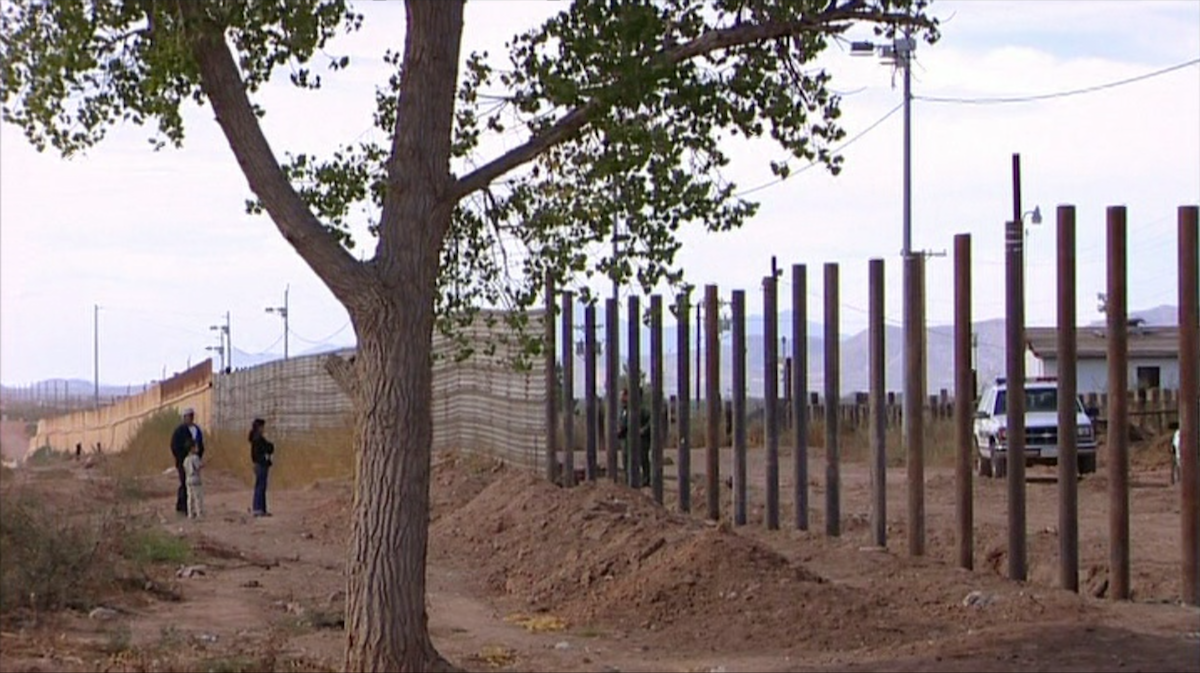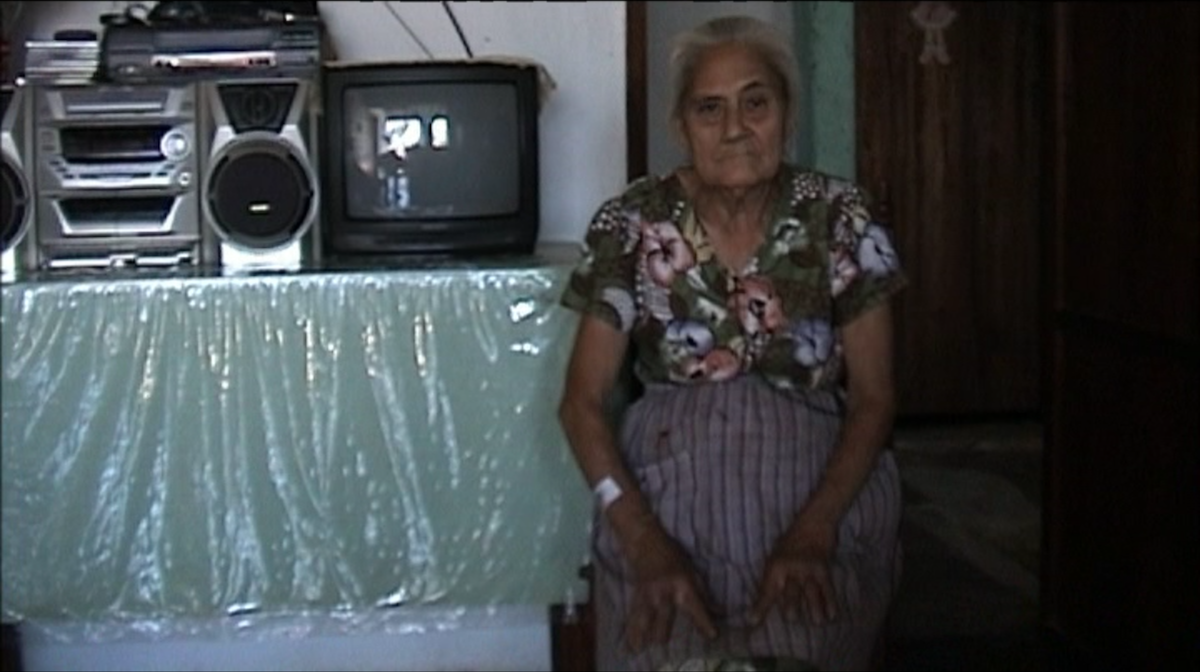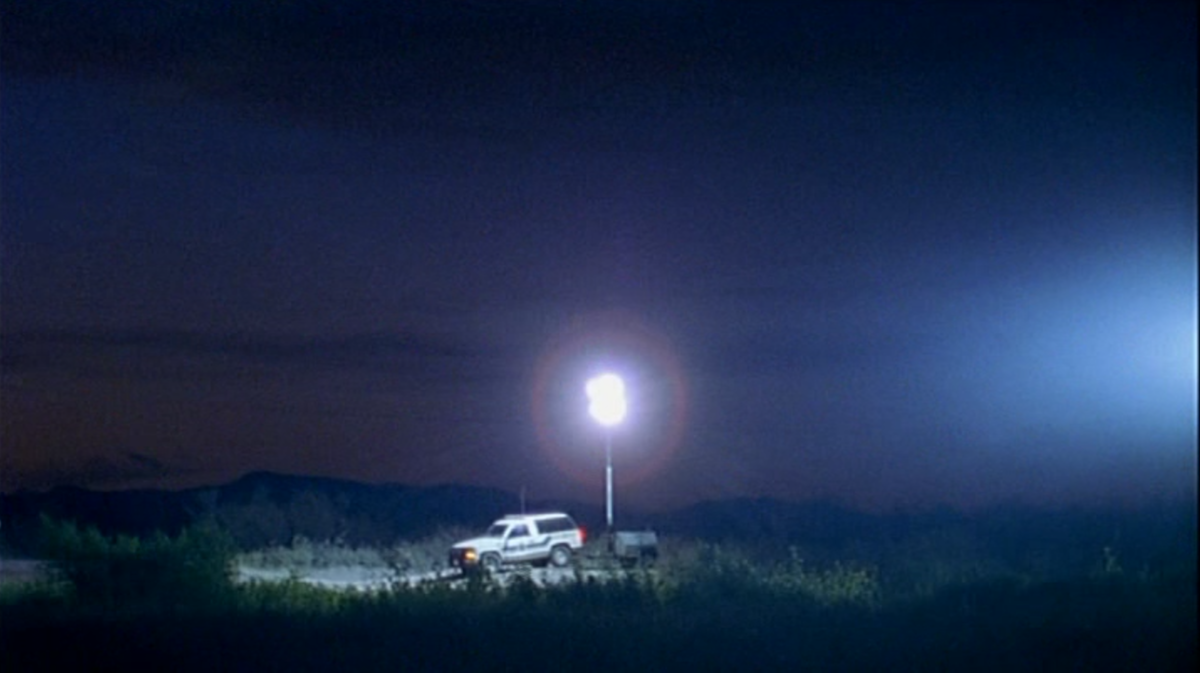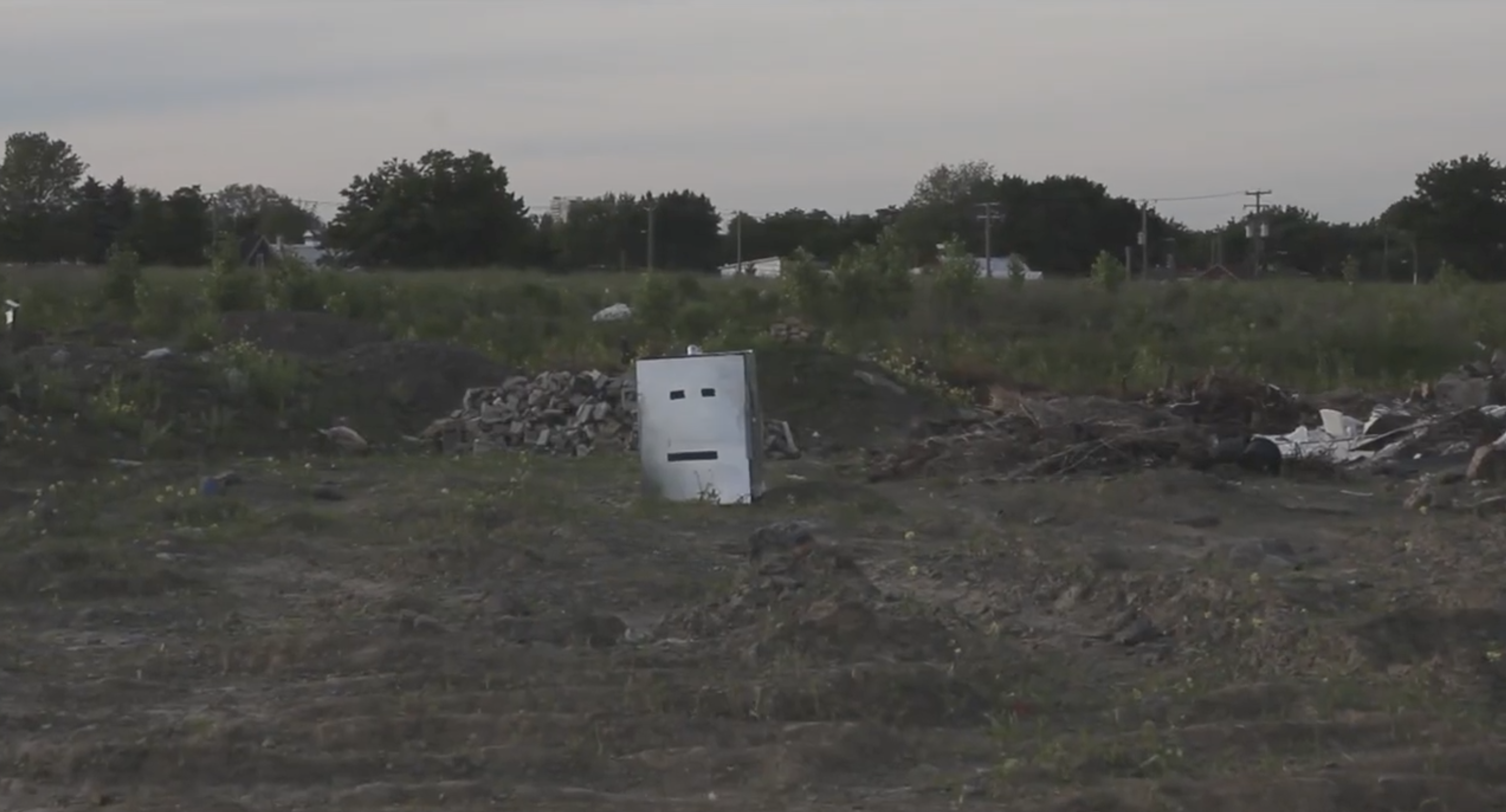Released in the aftermath of the 9/11 terrorist attacks, Akerman’s film explores the conflicts of people living along the US-Mexico border
In the middle of Chantal Akerman’s 2002 documentary From the Other Side is a shot so haunting that the entire film almost bends around it. Somewhere along the US-Mexico border, we see a “dead end” sign pummeled by gusting wind and sand during a storm. There are no people in the shot and little else to note beyond the few plants scattered around the landscape. The crunching sound of the wind against Akerman’s mic is oppressive and unsettling. In conjunction with the barren image, it feels post-apocalyptic, as if a bomb had just been dropped somewhere not far from where the camera is stationed. It would be fitting to read this moment in From the Other Side as Akerman’s assessment of the United States’ exceedingly dangerous and cynical immigration policies as representative of a “dead end” for the 21st century. Insofar as she made this documentary in the aftermath of the September 11 terrorist attacks and amid the beginning of the War on Terror, Akerman captured not only the United States’ regular indifference to the hardships faced by immigrants crossing the southern border, but she also identified the misconception that America could possibly safeguard itself from global crises like terrorism or undocumented immigration. In other words, without didacticism or sentimentality, Akerman observes the consequences of such a narrow and suspicious vision of the world.
Related: Listen to Art House Drive-In’s episode on Akerman’s News From Home (1977)
Filmed on the US-Mexico border, From the Other Side consists of Akerman’s interviews with immigrant laborers in the US, families of Mexican migrants who have died trying to cross the border, local US law enforcement, and American homeowners who see immigrants entering the country from Mexico as a danger that needs to be guarded against. As is true of Akerman’s visual style in Jeanne Dielman, 23 quai du Commerce, 1080 Bruxelles (1975), News From Home (1976), and Golden Eighties (1986), From the Other Side is characterized by frequent long takes fixating on interview subjects, towns and uninhabited areas along the border, and extended tracking shots of the constructed border as Akerman records it from her car. These long takes not only set the pace of From the Other Side, but they also represent an important, and complicated, aspect of the film’s politics. In one sense, when the most that happens in some of these shots is a Mexican or American interviewee talking about immigration, Akerman’s long takes highlight a profoundly ordinary experience of the border. For the film’s interviewees, the Mexico-US border is a place of pain and fear: Mexicans on both sides of the border talk about the difficulties they have encountered or the family members they’ve lost or been separated from; Americans give voice to an understandable terror at another terrorist attack happening in the country, but their scapegoating of Mexican immigrants and Muslims as threats to the nation is wrong. But the dangers that Mexicans and Americans face on the border, real or imagined as they may be, are simply part of the environment.

This is not to say that Akerman wants us to grow indifferent to the stories being told — like the one about a group of immigrants that was abandoned to die in the desert by their “coyote” guide. On the contrary, From the Other Side challenges such indifferent perspectives and recognizes that such apathy is overwhelmingly organized at an institutional level. This is represented by an interview Akerman includes with a US sheriff who explains that it is in fact the American government that is indifferent to such suffering. From the Other Side demonstrates that Mexicans who attempt to cross the border, or know someone who has, have to deal with this as part of their reality of being born on the “wrong” side of the border. To pursue the economic opportunities on the American side, immigrants cannot be ignorant of such dangers, nor can they be paralyzed by them. To a certain degree, immigrants and their families have to accept the absurdly violent situation on the border as normal and carry on with their lives.
This reality is heartbreakingly captured by Akerman’s interview with an elderly woman, Delfina Maruri Miranda, who lost her son, Reymundo, and grandson when they attempted to cross the border. With Akerman’s prompting, Delfina memorializes her son as an idealist who wanted to improve the status and resources of their poor, rural town. Reymundo wanted to bring home the financial gains that he imagined he would make in the US as others who made it across the border and back were able to do. Delfina speaks with a mixture of immense pride, sadness, and reluctance to even broach the subject. Indeed, there are moments during this interview when Akerman and her camera simply observe Delfina while she pauses between thoughts or stops speaking entirely. One gets the impression that there is a line that Akerman does not want to cross, yet the director remains entirely captivated by Delfina who just manages to carry on with her life even though she is sick with this pain.

This interview happens in two back-to-back long takes, for which Akerman uses a simple, but potent, mise-en-scène. Delfina sits to the right of the frame, and next to her is a stereo speaker system and a television that is either turned off or unplugged. In the blank screen, we can barely make out the reflection of someone — it doesn’t look to be Akerman, but perhaps another of Delfina’s children. At some point during the interview, a young girl appears in the background, hovering near the setup as if wanting to get Delfina’s attention but also not wanting to interrupt. In a moment, the girl leaves and Delfina asks a question to someone offscreen — seemingly, a family member and the person whose reflection appeared on the television. In this moment Akerman strikes a delicate balance between her fascination with Delfina and her self-awareness of how this fascination could be misconstrued or misunderstood by her audience. In this composition we can see that there is a world beyond the frame and that Delfina has a life not just outside of the film, but outside of this specific interview. To remember her son, to memorialize him, is both an everyday practice for this woman and something that demands her complete emotional attention. The self-referentiality of the interview, represented by the television, draws our attention to how easy it is for a film to turn such suffering into spectacle. However sympathetic the film’s treatment of Delfina might be, Akerman urges us not to define this woman by her suffering and to recognize that there is more happening in her life than this tragedy. In this sense, the very screen through which we watch From the Other Side constitutes another border — one that allows us to see this woman more clearly and humanely than the paranoid and xenophobic rhetoric of right-wing America would otherwise want us to. At the same time, Akerman’s presentation of Delfina, and the rest of her subjects, is necessarily selective — we can only get so close to them.
Related: Breaking Waves: Redes (1936) by Frankie Vanaria
Throughout the film, these long takes morph into liminal zones, spaces in which viewers are ambiguously positioned between sympathizing with immigrants and their families and surveilling them. Invariably, like with Delfina, Akerman lingers on her subjects long after they have ceased speaking. There is even a moment when a man sitting in a barber chair stares directly into the camera for several moments without saying anything. With this gesture, the viewers of From the Other Side are implicated as both participants within, and victims of, the brutalizing surveillance state that has defined the United States since 9/11. In all such instances in the film, Akerman’s immigrant subject and her audiences are hyper-aware of how long they are watching or being watched. Accordingly, during these interviews one can imagine that Mexicans on both sides of the border might be wondering who the viewers of this film might be or what consequences might come from putting themselves out there. Conversely, even in being made aware that they are part of a global surveillance apparatus, this is simply part of what became a new norm in the beginning of the 21st century. In that sense, as much as Akerman encourages her audiences toward some degree of introspection, From the Other Side does not push any further in its critique of such structures than that. To put it another way, while Mexican immigrants are risking their lives to cross the border, there is little that the average person can do other than bear witness to this horror.

For Akerman, whose mother survived Auschwitz, testimony that holds an historical evil accountable is a moral necessity, and she clearly feels a great deal of sympathy towards her subjects. At the same time, Akerman does not shy away from addressing the crisis being experienced by white Americans. In an interview with a Texan husband and wife, we hear about how America must be on guard because “they” perpetrated a horrific attack, which, the husband tells us, no one thought could happen. The couple go on to elaborate on apocalyptic scenarios in which immigrants crossing the border infect the country with disease and carry out another terrorist attack. When the wife rhapsodizes about how the US will have to prioritize the vaccination of children against the illnesses being brought over the border, it is notable that the couple’s grandchildren are nowhere present in the frame. This marks a clear contrast with Delfina’s interview, and Akerman conveys that even the genuine fear and pain that these Americans might feel is suffused with so much ideological hatred that even family members can become little more than rhetorical abstractions. But even without this careful framing choice, Akerman has to do little to demonstrate the absurdity of these people; simply speaking for themselves is enough. At one point, the husband begins talking about how he has signs posted along their property directing migrants not to trespass. Confidently, he tells Akerman that because they are in America these signs do not have to be written in Spanish. Almost immediately after saying this, he seems to recognize how ludicrous that idea is; the interview ends at that exact moment.
One might wonder why, especially if she finds the views that these people espouse to be so absurd and vile, Akerman would include them in her film — or why, even, she would not challenge them at any point during the interview. However, it seems out of place for Akerman to turn a blind eye to the fear that sustains nationalist rhetoric, or that, as someone who suffered from depression until her suicide in 2015, Akerman would position herself as an heroic figure taking these people to task. This is what makes From the Other Side feel like such a personal film for Akerman. Its intimacy and humanity are what allows it to be so moving, considering that America’s treatment of undocumented immigrants has worsened in the 20 years since From the Other Side was released.
Stay up to date with all things Split Tooth Media and follow Frankie on Twitter
(Split Tooth may earn a commission from purchases made through affiliate links on our site.)




